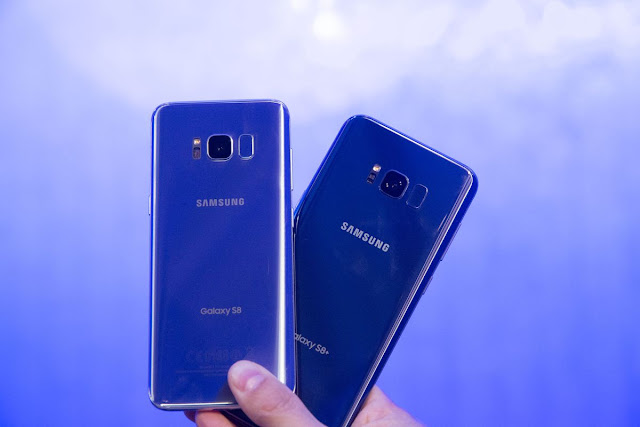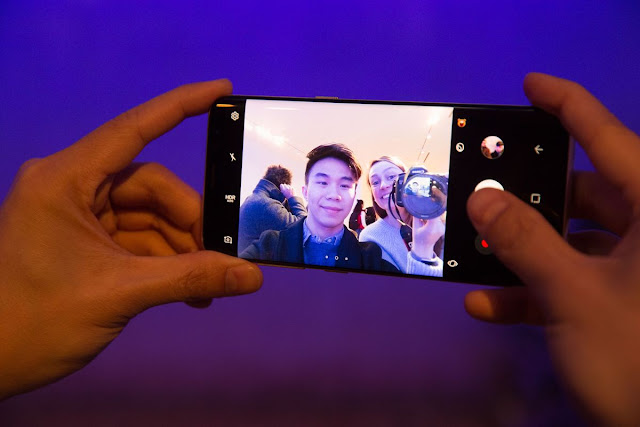No more leaks, guys. Samsung's next flagship phones, the Galaxy S8 and S8+, are officially official.
It's easy to look at the Galaxy S8 as just another annual phone release. The phone's definitely prettier, the screen's larger, and there's the very interesting Bixby AI assistant onboard. But it's not just another phone launch.
The Galaxy S8, which launches on April 21, is Samsung's first major phone launch since the Galaxy Note 7 explosions that ultimately ended with two global recalls and the device's discontinuation.
The Galaxy S8 will be judged not only by how it competes with the iPhone 7, but its ability or inability to restore consumer trust in Samsung.
Ten years after Apple unveiled the iPhone and and ushered in an era of touchscreen-equipped pocket computers, it's difficult to get excited for any new version of an established smartphone. At the end of the day, phones are phones (even if they don't have headphone jacks). These are a bit different, though, with an impressive screen and other unique features—but they come with a few disappointments at first glance.
More screen, less bezel
Samsung pioneered the modern phablet with the Galaxy Note and has embraced bigger screens for years—and it's finally killing the "small" option. The Galaxy S8 and S8+ have the largest displays of any Galaxy S (and Galaxy Note phone, for that matter) ever created, measuring 5.8 and 6.2-inches, respectively, with a resolution of 2960 x 1,440.
The Super AMOLED "Infinity Displays" have an unusual 18.5:9 aspect ratio, which is taller than typical 16:9 screens and just a hair wider than the new LG G6's 18:9 Full Vision display. Like the G6, the S8 and S8+'s display corners are rounded, and they look pretty hot. The screens are as vivid and sharp as you'd expect from a Samsung display, and they're HDR-ready.
Though the displays are physically taller (or longer in landscape mode), the two phones don't feel overwhelmingly huge, thanks once again to Samsung's signature curved edges, which help make the phones narrower.
Even though the S8 has a larger screen, its dimensions are about the same size as the S7 Edge, and the S8+ is only a little larger. In hand, Samsung's new phones feel just as solid as its previous flagships. The S8 and S8+ still sport the same iconic glass-and-metal sandwich designs, but the curved edges (both front and back) are now symmetrical like they were on the Note 7, making them easier and comfier to grip.
With 83 percent of the S8 and S8+'s front dominated by the display, there's no room for a physical home button like there is on the S7/S7 Edge. Instead, the phones have a virtual home button located on the bottom portion of the display that vibrates when you press on it. It remains to be seen if that'll work as well as a mechanical button.
But, wait, where's the fingerprint sensor if there's no physical button? Unfortunately, the rumors are true, and Samsung moved it to the back of the phone, right next to the camera. The new back-positioned fingerprint sensor just reads your fingerprint, and isn't a pressable button. And yes, unless you have super long fingers, the fingerprint sensor's not easy to reach, and you will end up smudging the back camera a lot.
On the plus side, like the S7, the Galaxy S8 and S8+ are IP68 dust and water-resistant, which means they're submergible in up to five feet of water for up to 30 minutes.
What's a new flagship phone if it's not faster? As we've known since last year, the S8 and S8+ come with Qualcomm's newest Snapdragon 835 system-on-a-chip (SoC), 4GB of RAM and run Android 7.0 Nougat with a redesigned TouchWiz skin. Both phones come with 64GB of storage and a microSD card slot for adding an additional 256GB more.
While the Snapdragon 835 offers roughly 27 percent faster performance than the 821 chip found in phones like the Pixel/Pixel XL and LG G6, it has another advantage: it's more efficient and uses about 40 percent less power than before
This increased power efficiency means the S8 and S8+ can last longer without needing higher capacity batteries. As such, Samsung's equipped the S8 with a 3,000 mAh battery and the S8+ with a 3,500 mAh battery. The phones also come with the same built-in wireless and Fast Charging that you've come to expect from Samsung's flagships.
And while it's impossible to verify, Samsung says it's taking extra precautions with a new eight-point battery safety check to ensure no S8 batteries explode. Samsung can't afford to have another phone literally go up in flames, so that better check out.
Sharper selfies
Perhaps more disappointing than the fingerprint sensor's terrible location is the lack of any significant update to the rear camera. There's no dual camera setup to compete with the iPhone 7 Plus or the LG G6; Samsung's sticking with the S7's 12-megapixel camera with f/1.7 aperture and Dual Pixel autofocus system. While the camera's imaging hardware is the same, Samsung says it's made several software improvements to speed up image processing and help reduce motion blur.
The S8 camera didn't feel any quicker than the S7, but our time with it was limited. That said, the S7 camera is quite good, especially in low light, so no big deal if it's an incremental improvement.
The camera that did get an upgrade, though, is the front-facing one. It's now 8 megapixels compared to the 5 megapixels on the S7, and it has a "smart autofocus" feature to lock onto faces and subjects.
I can't be certain since I didn't get to do any proper comparisons with other phones, but the selfies — at least on the S8's screen — looked a little crisper. I'll know for sure when I do some
Bixby brains
The most important new addition is none other than Bixby, the built-in AI assistant. Samsung sees Bixby as such a key part of the S8 and S8+ that it's got a dedicated activation button on the left side of the phone below the volume buttons.
Unlike assistants like Siri or Google Assistant, which are designed to answer common questions and perform simple actions, Samsung says Bixby is more intelligent and designed for "completeness," allowing you to use your voice for everything you would otherwise do by tapping your screen. In its current state, Bixby can control tens of thousands of complex actions within select Samsung apps, but the eventual goal is to have voice control for all apps — there's gonna be a Bixby API for third-party developers to work with.
In addition to more advanced voice controls, Bixby's also got super vision. Using image recognition in conjunction with the camera, the AI is able to identify objects and provide either additional information or suggest where you could purchase it. The feature resembles the Firefly feature on the ill-fated Amazon Fire Phone.
It's an ambitious project, and there are still many unanswered questions—like what Bixby's voice sounds like, how well it really works and where all of the data it collects is stored—but it feels like the right step towards making phone assistants actually useful. You can read more about Bixby's features here.
Unlock with your face
On the Note 7, Samsung offered two biometric ways to unlock the phone: fingerprint or iris scanner. The new S8 phones follow suit, and they add a new facial recognition feature that works well.
That feature unlocks the device when you look at the phone. It's a good alternative and functions well, but Samsung says it's less secure than the iris scanner.
 |
| The iris scanner is more secure, and now you don't need to line your eyes up with the two eye holes, or even have the eye preview on at all. |
 |
| There are even cartoony masks you can set up if you hate looking at your irises |
There's also an iris scanner as well. Unlike on the Note 7, you no longer need to line your eyes up with the circles on the screen. It's much better and faster this time around.
Growing pains?
A year ago, when I got a preview of the Galaxy S7 and S7 Edge, my first impression was that Samsung had finally made phones with virtually no compromises. Even before reviewing the S7 and S7 Edge, I said they already felt like the best Android phones ever made (and they were when I reviewed them).
I can't say I had the same first impression for the S8 and S8+. Samsung's newest are certainly gorgeous, fast, and feature-packed — they've got headphone jacks, yes! — but they seem to be full of trade-offs. To get the bigger screen and slimmer bezels, the fingerprint sensor's moved to a weird spot; the rear camera's the same old one; there are no stereo speakers, and the new facial recognition unlock system is convenient but not as secure as the iris scanner, etc.
It's possible these initial quibbles will be non-issues in everyday use, but that they exist at all worries me a little.
The S8 and S8+ will be available worldwide on April 21. In the U.S., the phones will be available in three colors: Midnight Black, Orchid Gray and Arctic Silver. In South Korea, Maple Gold and Coral Blue will also be color options.
Pricing varies between carriers. Verizon's selling the S8 for $730 and the S8+ for $840. AT&T and T-Mobile are selling the S8 for $750 and the S8+ for $850. And MetroPCS will sell the S8+ for $730.
















Comments
Post a Comment